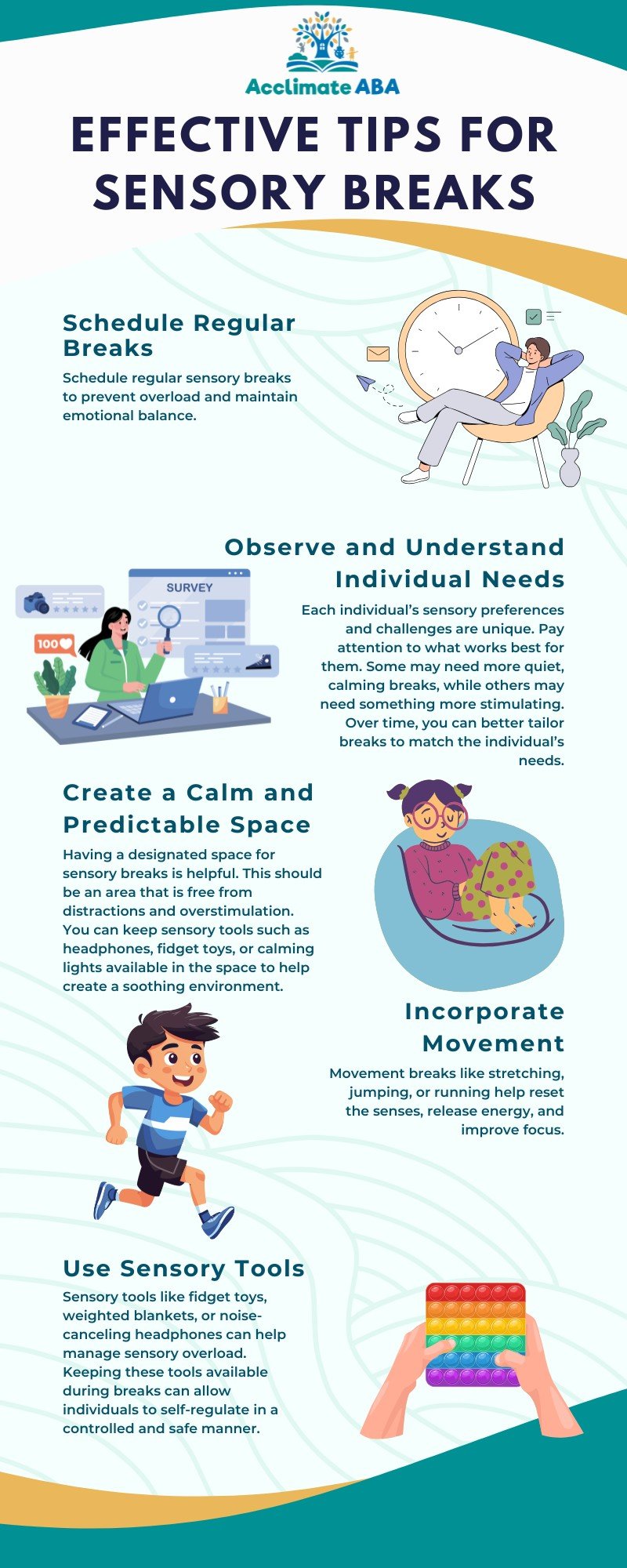Sensory Breaks for Autism: Tips and Activities
 Key Points:
Key Points:
- Sensory breaks for autism are essential for self-regulation and reducing sensory overload.
- Sensory breaks can help individuals with autism manage stress, maintain focus, and enhance their emotional well-being.
- Effective sensory break activities include a variety of techniques tailored to individual sensory needs.
For many individuals with autism, sensory overload can become overwhelming, leading to emotional distress or difficulty concentrating. According to studies, around 90% of individuals with autism deal with atypical sensory experiences.
Because of this, sensory breaks are essential for helping individuals take a step back, manage their sensory needs, and avoid becoming overstimulated. Sensory breaks can be a game-changer in helping adults and children with autism process overwhelming sensory input, manage their emotions, and enhance their focus.
In this article, we will dive into the importance of sensory breaks for autism, what activities can be used during these breaks, and how to incorporate them into daily routines. These breaks are essential tools that can support emotional regulation, boost attention, and reduce anxiety in sensory-sensitive individuals.
What are Sensory Breaks for Autism?
Sensory breaks for autism refer to short periods during the day when an individual can engage in an activity designed to help them manage sensory input. These breaks allow individuals with autism to step away from potentially overwhelming environments and reset their sensory systems.
Sensory breaks are especially important because they provide an opportunity to reduce or increase sensory stimuli depending on the individual’s needs. For some, sensory breaks involve calming activities, while others may need more stimulating activities to help them feel more engaged or regulated. These breaks can be as simple as taking a walk, using sensory tools, or engaging in a structured activity that meets their sensory needs.
Are Sensory Breaks Necessary for Children with Autism?
If you’ve ever noticed your child becoming overwhelmed or frustrated in busy environments, you might already have an idea of how important sensory breaks can be. For children with autism, sensory experiences can be heightened, making everyday situations feel intense or even overwhelming. Sensory breaks are a simple, effective way to help kids reset, self-regulate, and avoid sensory overload.
Sensory breaks are more than just a pause in the day; they’re an essential tool for helping children with autism feel balanced, focused, and ready to tackle whatever comes next. Sensory breaks aren’t just nice to have—they’re necessary for supporting emotional well-being and creating a calm, productive routine.
Incorporating sensory breaks into your child’s routine doesn’t have to be complicated. It can be as simple as allowing them to take a few minutes to sit in a quiet space, squeeze a stress ball, or even take a quick walk outside. The key is to identify activities that help your child feel grounded and relaxed. Over time, you may notice which types of sensory breaks work best for them.
Benefits of Sensory Breaks for Autism
Sensory breaks are essential for several reasons. For individuals with autism, sensory processing differences are common, meaning they might experience heightened or diminished responses to sensory stimuli. Without proper breaks, this can lead to sensory overload, causing stress, anxiety, or meltdowns.
The benefits of sensory breaks for autism include:
- Emotional Regulation: Taking breaks helps individuals manage frustration, anxiety, and sensory overload, leading to better emotional regulation.
- Focus and Attention: Sensory breaks provide a moment for the brain to reset, helping individuals refocus on tasks when they return.
- Stress Reduction: Sensory breaks give individuals time to unwind, reducing feelings of stress and tension that can accumulate throughout the day.
Understanding the importance of sensory breaks helps to see them not as interruptions but as necessary strategies for improving quality of life and supporting daily functioning.
 6 Sensory Break Activities for Autism
6 Sensory Break Activities for Autism
Now that we’ve covered the importance of sensory breaks let’s explore specific activities that can be included in sensory breaks for autism. These activities are designed to help engage and regulate the sensory system, promoting emotional well-being and relaxation. Below are some examples:
1. Deep Pressure Stimulation
Deep pressure can be calming for many individuals with autism. Activities like using a weighted blanket or engaging in a deep-pressure massage help to regulate the nervous system and reduce anxiety. For some, this can be a soothing activity that improves emotional well-being.
- Examples: Weighted blankets, hugging vests, or sensory brushes.
- Benefit: Provides a calming and grounding experience.
2. Sensory Fidget Tools
Fidget toys are great for tactile input during sensory breaks. These tools can help adults and children with autism focus or calm down by providing a controlled outlet for their sensory needs. Fidgeting with these objects helps manage excess energy and can reduce feelings of stress.
- Examples: Fidget spinners, stress balls, or textured cubes.
- Benefit: Provides tactile stimulation and helps to regulate sensory input.
3. Soothing Sounds or Music Therapy
Music is an excellent way to manage sensory overload and provide calming input. Whether it’s calming classical music or listening to nature sounds, soothing auditory experiences can help individuals with autism calm down during sensory breaks. Some may also prefer using noise-canceling headphones to block out overstimulating background noise.
- Examples: Nature sounds, classical music, or white noise.
- Benefit: Promotes relaxation and reduces anxiety.
4. Swinging or Rocking
For many individuals with autism, rhythmic movement like swinging or rocking is deeply soothing. These activities provide vestibular input, which can help calm the nervous system and improve focus. Setting up a swing or rocking chair can offer a calming break during overwhelming moments.
- Examples: Hammock swings, rocking chairs, or rocking toys.
- Benefit: Calming rhythmic movement that helps with emotional regulation.
5. Art and Creative Expression
Art can be a therapeutic outlet for sensory expression, allowing individuals to engage with various textures, colors, and materials. Whether it’s painting, drawing, or playing with clay, creative expression offers an immersive sensory experience that can be both stimulating and calming.
- Examples: Drawing, painting, or playing with clay.
- Benefit: Provides a sensory outlet and encourages creativity.
6. Bouncing on a Trampoline
For more active breaks, jumping on a trampoline can provide both sensory and physical stimulation. This activity helps with proprioception and can help individuals reset by expelling excess energy and improving circulation. It’s a fun way to get out of a sensory overload.
- Examples: Small indoor trampolines or large backyard trampolines.
- Benefit: Physical activity to release energy and promote sensory regulation.
7. Aromatherapy and Essential Oils
Aromatherapy is another way to manage sensory input during breaks. Calming scents like lavender or chamomile can help reduce anxiety and promote relaxation. Essential oils can be used in diffusers or applied in small amounts to a scarf or wristband.
- Examples: Lavender, chamomile, or citrus scents.
- Benefit: Calming or stimulating scents for emotional regulation.
Promote Sensory Regulation with ABA Therapy in Utah
If you’re looking for additional strategies to support sensory needs, Acclimate ABA offers ABA therapy in Utah designed to help individuals with autism manage sensory regulation, improve focus, and develop self-control. ABA therapy is an evidence-based treatment that can teach individuals with autism how to better navigate sensory overload and emotional challenges in daily life.
By integrating sensory breaks into the therapy routine, Acclimate ABA ensures a holistic approach to well-being. Reach out to us to learn more about how our ABA therapy programs can help enhance your loved one’s quality of life.
